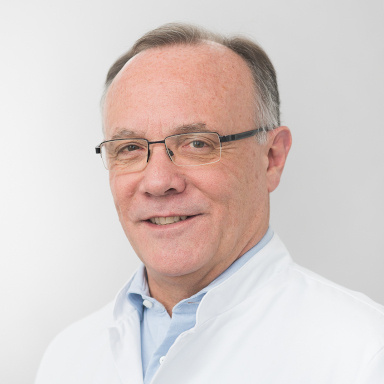A cancer diagnosis is often a drastic experience for patients. Cancer treatment, however, is progressing rapidly and thus offers new opportunities for patients. A personalised diagnosis, interdisciplinary treatment recommendations agreed in tumour boards, and combined treatment methods are therefore crucial.
At the Hirslanden Private Hospital Group in Switzerland, qualified specialists work together in interdisciplinary networks to provide the best possible comprehensive care. Each patient is provided with individualised and holistic care tailored to meet their specific needs and they can look forward to ongoing, long-term support.
In addition, all our doctors speak English. In case of language difficulties, we will happily organise an interpreter.
Examination and Diagnosis
Examination and Diagnosis
To make an accurate diagnosis for suspected cancer, the specialist has to evaluate the patient’s physical condition thoroughly. For examining the patient, our oncologists have access to a variety of diagnostic methods.
Examination methods:
- MRI
- CT
- When examining for breast cancer: mammography
- When examining for prostate cancer: PSA
- Blood Examination
- Biopsy
- Puncture
- Molecular Genetic Analysis
Our Hirslanden clinics provide the most modern medical infrastructure allowing our oncologists to diagnose potential cancer diseases rapidly and precisely.
Forms of cancer therapy
Forms of cancer therapy
Today, the most modern cancer therapies include:
- Immunotherapy
- Chemotherapy
- Irradiation/Radiotherapy
- Stem Cell Therapy
- Operation/Surgical Procedure
The treatments are applied simultaneously and in combination, depending on the cancer type and the patient’s general condition.
The complexity of tumour diseases demands the cooperation of different specialists. In weekly meetings, the Tumourboards, every case is discussed interdisciplinarily. As a result, our specialists determine the best possible treatment for every patient.
Cancer Prevention
Cancer Prevention
Cancer that is identified early can be cured in most cases. To cancer applies: The earlier the diagnosis, the better are the chances for curing it. With regular medical check-ups, the risk of severe cancer disease can be reduced significantly.
Get more information about preventive examination at Hirslanden.
Facts
Facts about the most common cancer diseases
Breast cancer and prostate cancer are the most common types of cancer that occur to women and men. We have collected facts about the these two most common cancer afflictions.
5 facts about breast cancer:
- 5 500 women develop breast cancer each year; around 90% of patients have a good chance of recovery if it is diagnosed early.
- The type of breast cancer treatment is based on the tumour size and the stage of the disease.
- After successful therapy, regular follow-up checks should be carried out.
- A healthy lifestyle, regular exercise and a healthy diet reduce the risk of breast cancer.
- The pink ribbon is an international symbol that expresses solidarity with women affected by breast cancer.
5 facts about prostate cancer:
- The prostate is a gland about the size of a chestnut, situated beneath the bladder.
- Prostate cancer is the most common type of cancer in men.
- The chance of recovery is around 90% if it is discovered early.
- Check-ups help to recognise malignant prostate disease early on and treat it successfully.
- Two examination methods are used for the early detection of prostate cancer: rectal examination and determining the PSA value in the blood.
Malignant and benign tumours
Benign tumours are cell growths whose genetic material is the same as the rest of the body. They are unable to infiltrate and destroy neighbouring tissue. Benign tumours do not form metastases. However, they can become dangerous if their growth puts pressure on vital organs or causes severe bleeding.
Malignant tumours are cell growths with altered genetic material. These cells are no longer controlled by the body, so they are characterised by unrestricted growth. As they grow, they infiltrate healthy tissue and destroy it. The cells of a malignant tumour can travel through the bloodstream to reach other parts of the body. There they can form metastases, which can destroy the surrounding tissue.
Cancer types
Under the following links you will find detailed information on selected cancer types:



